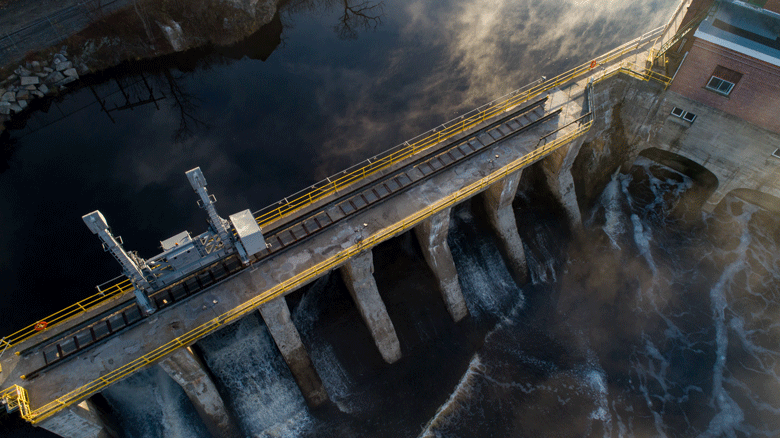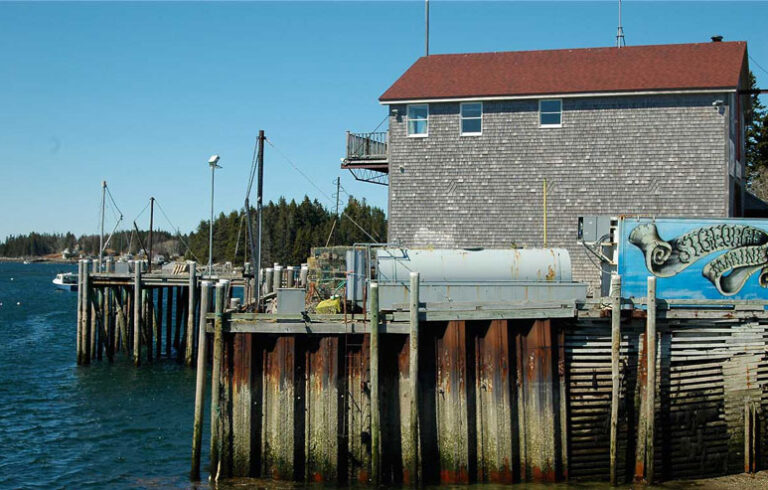Ten years ago, the run of alewives in the Skutik (St. Croix) River hovered around 16,000. Though that’s more than the 900 fish from a decade earlier, it was not a great total for a river that once held millions of fish. It was, however, the beginning of what many people now consider a successful river restoration.
One of those people is Hugh Akagi, chief of the Peskotomuhkati Nation in New Brunswick. Akagi, 78, told the success story to hundreds of scientists, students, and supporters at the 2024 Atlantic Salmon & Their Ecosystems Forum in Orono in January.
Akagi wore a thin black headband around his shoulder-length gray hair and a black, red, and white ribbon shirt. He walked back and forth at the front of the room.
The current alewife population is but a fraction of what has been called “the greatest production potential of any watershed in Maine…”
“The problem,” he told the rapt audience, “was that people had been going at the restoration from the wrong end. They thought they would go to the top and work their way down.”
Akagi, other Passamaquoddy leaders, and allies knew they had to do something.
“Governments aren’t doing it,” they told themselves. “We have to do it. But we are small. How can we do it?”
They did it together—Akagi, and Dale Mitchell, and Brian Altvater, and Vera Francis, and the rest of the Schoodic Riverkeepers. Scientists supported Indigenous knowledge with conventional research to show that native, sea-run alewives are a beneficial source of food and nutrition for other river inhabitants, native and non-native.
Ed Bassett debunked the myth that alewives never traveled above Grand Falls and created a video of the river that made members of the U.S.-Canada International Joint Commission cry. Ever the runner, Bassett collected signatures when they were needed and brought them to Maine’s capital in Augusta, where he found other people in the hearing room—from the Penobscot Nation, Atlantic Salmon Federation, environmental groups—who supported getting little fish up the river. It was grassroots.
Once they knew there was a truth to be heard, said Akagi, the government started to move, opening the fishway at the Woodland dam in 2008 and Grand Falls in 2013. Alewife numbers increased; 800,000 returned to the Skutik in 2023.
Sarah Bland, deputy administrator of the NOAA Fisheries Greater Atlantic Region, called the St. Croix restoration a success of salmon recovery efforts. “Restoration of fish passage on the river is largely attributable to the leadership of the Passamaquoddy.”
Chief Akagi, who has a degree in math and physics and worked for Fisheries and Oceans Canada, reminded the crowd that success is not the same thing as greatness. The current alewife population is but a fraction of what has been called “the greatest production potential of any watershed in Maine, the Northeast, the United States, and probably North America,” according to the 2022 Skutik Watershed Strategic Sea-Run Fish and River Restoration Plan.
Migration routes are impeded by five major dams, and the reservoirs in between are full of hungry, non-native smallmouth bass. Though salmon are present in the lower tributaries, none have been documented in the mainstem since 2006.
Attendees at the meeting were also reminded that climate change is the single biggest threat facing Atlantic salmon. Researchers are increasingly trying to understand the consequences of warming water, especially in headwater streams and the upper reaches of rivers where persistent patches of cold water can offer refuge for salmon at all life stages and seasons. Identification and protection of these cold-water streams is a priority for salmon researchers. But they know they can’t focus only on salmon.
Salmon habitat does not function properly without alewives, sea lamprey, and other migratory fish, said Tim Sheehan of NOAA Fisheries.
“The native suite of sea-run fish convey specific benefits to Atlantic salmon, including delivering marine-derived nutrients, providing prey items, conditioning habitat, and likely reducing predation risk via prey buffering.”
While this knowledge is not new, Sheehan described how they are getting closer to incorporating other species into the salmon recovery process.
Officially endangered since 2000, salmon were not among the “success stories” told to celebrate the 50-year anniversary of the Endangered Species Act, marked in 2023.
But success depends on the measure, and who is doing the measuring. To the people gathered at the University of Maine on the eve of what would turn out to be yet another damaging storm of warm wind and rain—people who collectively represented centuries of knowledge about the “salmosphere”—success might be measured not by flow charts and Venn diagrams, strategies and plans, but by the very fact that Atlantic salmon with wild ancestry are still making their way thousands of miles to Arctic waters and back to Maine, as they have done for thousands upon thousands of years.
Millions of alewives returned to the Kennebec, the Penobscot, and the St. Croix in 2023. This is success story. But, as Chief Akagi noted, it is not a great story.
“We’ve done incredible things on the river,” he said. “It’s not enough.” Not enough fish, and not enough people.
“I can’t do it by myself, we can’t do it as a people, we’re too small. We need everyone.” Take these stories, he said. Tell them to others. Tell your river story.





